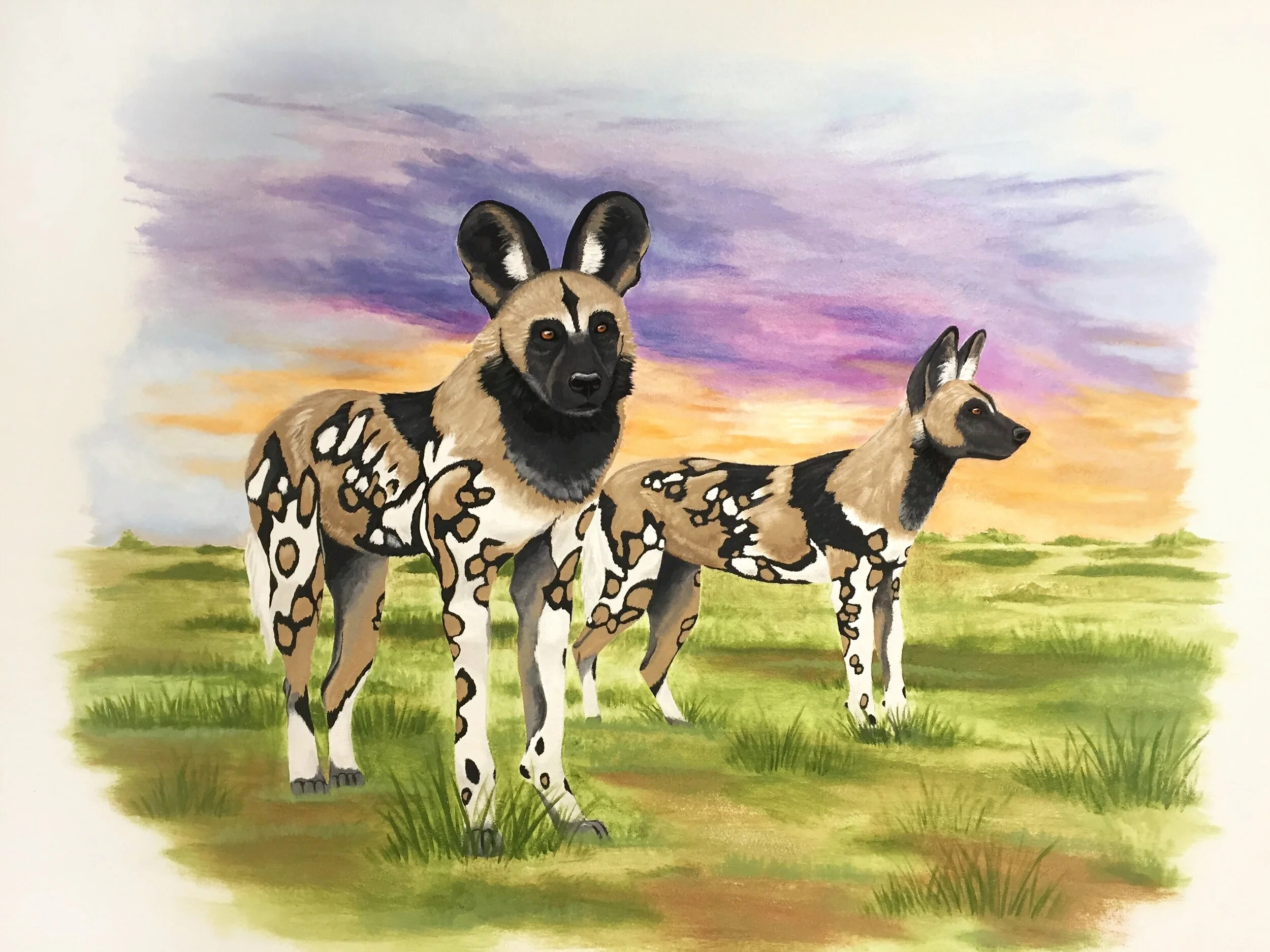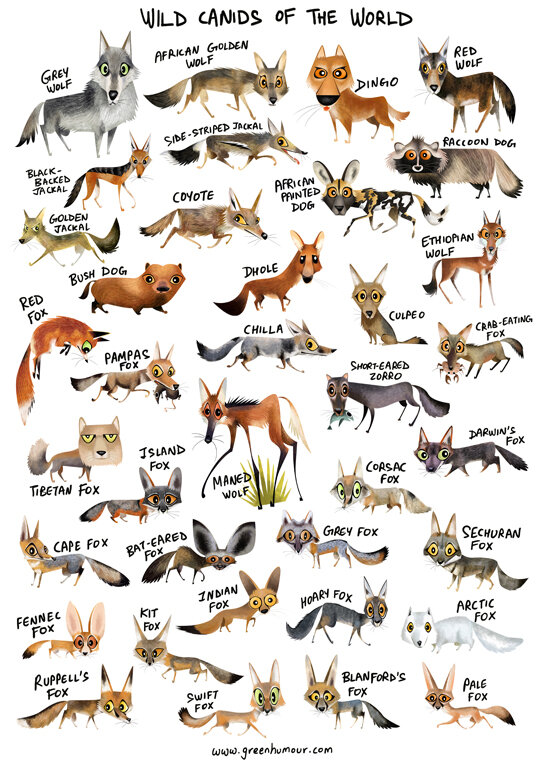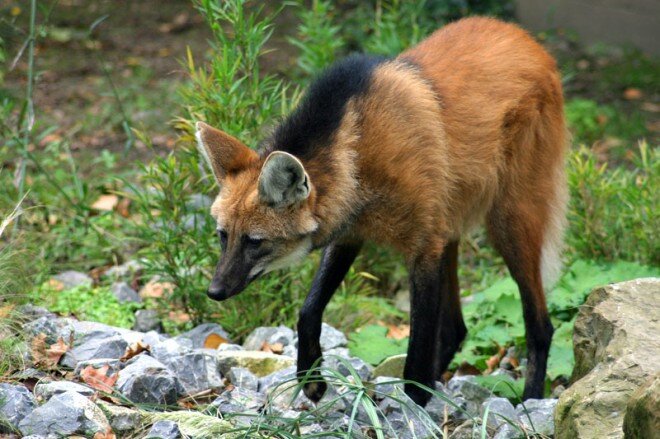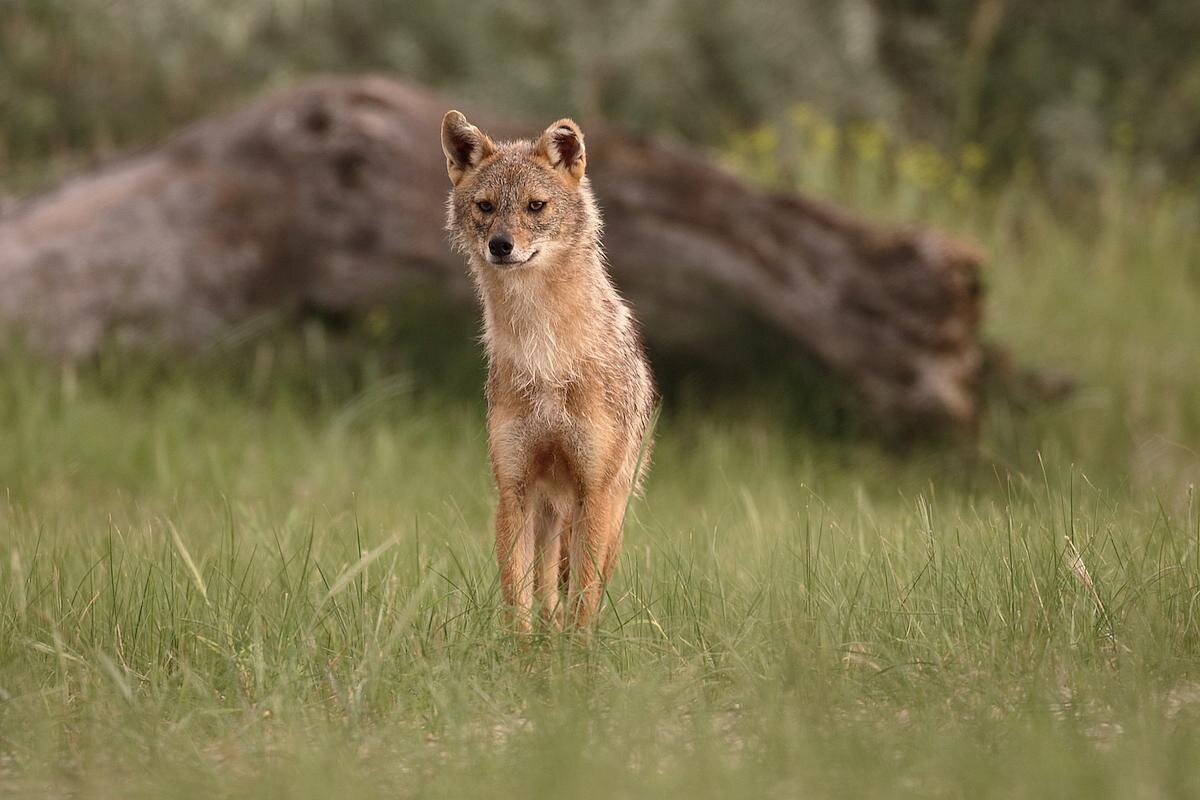What’s a Canid?
A canid is a mammal in the biological family Canidae. This family includes foxes, wolves, dogs, coyotes, jackals, and more.
Canids first evolved about 40 million years ago in North America. By using both the Bearing sea land bridge and the bridge created by the uncovering of Central America, over a span of millions of years, they were able to greatly expand their range. Now, they extend the world over and inhabit all continents with the exception of Antarctica.
A canid was the first animal to be domesticated, as the dog descended from their wild wolf counterpairts.
Canids vary widely in size. The smallest canid is the fennec fox, at about 24 cm (9.4 in) in length and 0.6 kg (1.3 lb) in weight. The largest canid is the gray wolf, at up to 160 cm (5.2 ft) long, and weighing up to 79 kg (174 lb).
Some canids have a purely carnivorous diet (like the African painted dogs and dholes) and some are omnivores (coyotes and red foxes), but none are solely herbivores. This can be determined by their dentition that consists of sharp canine teeth and the carnassials (the upper pre-molar and lower molar), which are optimized for shearing meat and tendons. The upper is used for cutting and the lower carnassial is used for grinding. The ratio between the upper and the lower defines the canids dietary habits.
Canids are often very social animals, living in large packs. Dholes have been known to have packs with up to 40 members. This social nature could explain why it was a canid that first came out of the wild and formed a special partnership with humans.
Canids are truly a treasure of the natural world.
Examples of Canids
The Dhole
Ben, The Dhole
Hyālō! (Bengali for “hello”)
My name is Ban Kutta, but you can just call me Ben. I am a Dhole (Cuon alpinus). I am sometimes called the Indian Whistling dog, Asian wild dog, and the mountain wolf.
I am native to South Asia, which includes India and China and some other places as well. I am found in tropical, dry, and moist deciduous forest; evergreen and semi-evergreen forests; dry thorn forests; grassland–scrub–forest mosaics; and alpine steppe, but not in desert regions.
I am a bit of a social butterfly, living in packs of up to 40 members. My pack mates and I are very effective hunters. We live largely on a diet of deer but with the help of my buddies I can take down pretty much anything.
I usually weigh around 40 pounds and have dark brown and white hair. I am quite beautiful, if I don’t say so myself. I am the only member of the genus Cuon, which is genetically close to dogs and wolves, but I have unique anatomical traits. I have a convex skull and one cusp on my upper molars. This makes me pretty special.
Unfortunately I am considered Endangered. There are likely fewer than 2500 dholes alive. We used to range through North America, Europe and much of Asia but no longer. People in my range often think I attack their domesticated animals, but in fact I rarely do. On account of this, we are persecuted. This means being poisoned, shot, snared and clubbed. We did nothing wrong so I hope this makes you as mad as it does me. There are some conservation groups devoted to educating people about us, like the JABCECC and some that focus exclusively on ensuring our survival. If you don’t know about us, you likely cannot help save us.
The Maned Wolf
Mateo, the Maned Wolf
Ola! (Portuguese for “hello”)
My name is Mateo, and I am a Maned Wolf (Chrysocyon brachyurus)!
I am a native of South America. I live in the grasslands and dry scrub forests of Brazil, Bolivia, Paraguay, and Northern Argentina.
I am a shy and timid canid who usually lives a solitary life. I am an omnivore, which means I eat a combination of fruits (my favorites are wolf apples, bananas, apples and avocados), vegetables, and prey such as rodents, frogs and small birds. My nickname is “fox on stilts” because of my foxlike characteristics of a red coat, shaggy white tipped tail, big ears, and my exceptionally long legs. Reaching a height of three feet at my shoulder, I am the tallest wild canid on earth. Despite our name, maned wolves are not actually wolves. We are the only members of our genus and have features that definitely make us canids, but we are not closely related to wolves or foxes.
Maned Wolf
I am Near Threatened in my native habitat range. This is because of habitat loss, disease, and the incorrect belief that some of my organs can be used for medicinal purposes. My family and I are misunderstood and wrongfully persecuted. We have been hunted by farmers for many years who were concerned we were killing their poultry and livestock. Since my teeth and jaws are so small, it is hard for me to kill large prey, but I am often blamed anyways because of my intimidating size. Some conservation groups are working on educating the local communities and protecting my home, so I have space to live.
Mexican Grey Wolf
Joaquin, the Mexican Grey Wolf
¡Hola! (Spanish for “hello”)
My name is Joaquin, and I am a Mexican Grey Wolf (Canis Lupus baileyi). I am called the lobo in Spanish.
I am native to North America and I once lived in mountainous forests and scrublands in northern Mexico, southern New Mexico, western Texas, and southeastern Arizona. Currently, I am being released into these areas thru conservation programs. I am a sub-species of the Grey Wolf. Even though I am called a Grey Wolf, my fur is a mixture of grey, tan, rust, and black. We usually grow to be 50-85 lbs, making us the smallest subspecies of Grey Wolf. I am a carnivore, and I eat a balanced diet consisting of meat and more meat! I like to eat elk, mule deer, rabbits, ground squirrels, and other small mammals. If I am living in a populated area, I am nocturnal (active at night), otherwise I am diurnal (active during the day).
Source: US Fish and Wildlife
Our conservation status is listed as Endangered. We used to have populations in the thousands, but due to human encroachment only a handful of us remain by the 1970’s. Thanks to reintroduction efforts from zoos and conservation centers, we can again be found in Northern Mexico and the Southwestern United States. Our numbers are slowly growing, but we are still the most endangered wolf in the world. Humans are our greatest threat because we are hunted for pest control. Another threat we face is loss of habitat.
Please help us by using your voice. Please vote to maintain preserves and state parks to prevent further loss of our home. Please protect my family and me by asking local, state and federal governments to stop the slaughter of wolves.
African Painted Dogs
Jambo! (Swahili for "hello")
Our names are Picasso & Van Gogh and we are African Painted Dogs (Lycaon pictus).
We are also known as African Wild Dogs, African Painted Wolves, or Cape Hunting Dogs. We are native to Southern and Eastern Africa and live in the savannah or sparse woodlands.
Picasso & Van Gogh, The African Painted Dogs
We are very social and live in large packs. We are known to share food and even help our sick family and friends. We can grow to be about 40-80 lbs. Before our pack leaves for a hunt, we actually vote by sneezing! The more sneezes that occur, the more likely it is that we’ll go! Our packs hunt cooperatively for antelope, or larger prey like wildebeests. We will settle for birds and rodents if we have to. Ah-choo! Our coat patterns are very pretty, full of color and pattern variation. Our coats can be used to identify individuals since no two are alike.
Painted Dogs are one of the most Endangered mammals in the world. Scientists who study us predict that there are only 3,000 to 5,000 of us left on the planet. Our populations are decreasing due to habitat loss, and fragmentation (the free space that we call home is shrinking and becoming separated). We are hunted by people who fear that we might harm their livestock. We are also exposed to diseases from domesticated dogs that our bodies cannot fight. People can help me by creating paths or corridors between wildlife preserves and teaching locals how to co-exist with us. Farmers can build bomas, which are homes for their livestock, to keep us out. Locals can also vaccinate their pets to prevent the spread of distemper and rabies
Arctic Fox
Halu! (Inuktitut for “hello”)
My name is Aurora. I am an Arctic Fox (Vulpes lagopus).
Vulpes lagopus means “hair on feet,” which references the hair between the pads on my paws. I am native to Arctic regions in the Northern Hemisphere all over the world.
Aurora, The Arctic Fox
I live in an underground burrow that helps protect me
from the harsh arctic climate. I am the size of a large housecat, usually weighing about 6-17 lbs. My diet consists of small rodents, usually lemmings
and voles, as well as fish, and other sea life. I have thick white fur in the winter and grey-brown fur in the summer to help me camouflage or blend in with my habitat. We Arctic foxes are monogamous and choose a mate for life.
If you want to help us, please do not buy fur, support people who wear fur or fashion houses that sell fur. Our story does not end there. We are also experiencing the negative effects of climate change, and temperatures in the Arctic are rising twice as fast as the rest of the world. This is reducing sea ice and causing sea levels to rise. You can help my family (and yours) by fighting climate change! It might sound silly, but every little bit helps! If everyone made small changes in their lifestyle, the effects would be huge! Remember to turn off the lights when you leave a room and unplug rarely used appliances. Reduce your waste, reuse what you can, and recycle! Use re-useable items rather than single use. Walk or ride a bike when you can instead of taking the car, or setup a carpool. All of these things add up and will make a positive change! Thank you for being green for me and our planet!
Our population is stable and we are of Least Concern for conservation. We were once greatly impacted by hunting for our lovely coats, but thankfully, this is becoming less common. Unfortunately, now we find ourselves living horrible lives and horrible deaths on fur farms around the world for vanity and the fashion industry.
Coyote
Hello! My name is Dusty, and I am a Coyote (Canis latrans)!
Dusty the Coyote
I am native to North America and I live in open spaces and urban areas throughout most of the continent.
I am cathemeral (awake day or night), and I am most active at dawn and dusk. I only weigh about 18-45 pounds. My family and I are excellent runners and we can reach speeds of 40 miles per hour and jump a distance of 13 feet! I am omnivorous and I typically hunt for small animals like rabbits, rats, mice, gophers, and insects. Because I am a bit of a scavenger, I will also eat from your garbage can, or find any food or water that you leave outside for your pets. I’m really not picky, and who doesn’t enjoy a free meal? Sometimes if I’m really hungry, I might even go after your family pets. Unfortunately, your Chihuahua is a lot easier to catch than an athletic bunny, but there are things you can do to help avoid this.
My population is of least concern, but we are persecuted. There is a lot about us that is misunderstood. I almost always hunt alone, not in packs as many people believe. I am naturally timid. In many ways I am curious and can be playful just like your dog, but I really mean no harm. Since human housing continues to expand, we need to learn how to co-exist. If you live in my neighborhood, please keep your pets close and stay alert. I do not like confrontation and will usually avoid you. If we get too close for comfort, you should make and maintain eye contact, pick up your dog if possible, wave your arms, and make loud noises so I will go away. If this does not scare me off, I am likely protecting pups, my den, or food. Calmly take your pets and leave the area. Please understand that I am trying to live in your world, but you are taking over mine. If you respect me and my family, and try to eliminate things that attract us, we can greatly reduce negative encounters.
Golden Jackal
Jackie, The Golden Jackal
Bună! (Romanian for “hello”)
My name is Jackie. I am a Golden Jackal, (Canis aureus).
I am native to Southeast Europe and all the way to Southern Asia. I am found in valleys, beside rivers and their tributaries, canals, lakes, and seashores and even in forests and on low mountains. I avoid desert areas because frankly, just thinking about them makes me thirsty. On account of having such a wide range and living in many different habitats, there are at least 7 different subspecies of blokes like myself.
I weigh around 30 pounds but we can weigh down to 13 pounds. I have an exquisite gold and grey coat and I know I am very pretty. I have a very good sense of smell, in fact even better than a dog. In Russia, they have bred golden jackals to dogs to create a hybrid canid for detecting explosives. So we are working to protect your lives...you’re welcome.
I am sometimes confused with some distant relatives in Africa called the black-backed jackal and the side-striped jackal, but I am actually more closely related to wolves and coyotes. I live in packs that generally consist of my mate and our offspring. My range is expanding because humans keep killing wolves, which is terrible. Now don’t get me wrong, if I see a wolf, I leave with great urgency. I could be prey for a wolf but I still think they are pretty cool.
For reasons I don’t fully get, we have been talked about in ancient texts quite a bit. The Egyptian god Anubis had the head of a jackal. Jackals are mentioned in the Bible 14 times and in some religions we are considered the first animal created. I get that one, I have always thought of us as #1.
We are not endangered but because we are so adaptable we sometimes live around humans, who can kill us because they are afraid. Now I only weight 30 pounds so I think you are overreacting a bit. It’s always drama with those humans.
New Guinea Singing Dog
Halo! (Tok Pisin for “hello”)
My name is Huli, and I am a New Guinea Singing Dog (Canis familiaris halistromi).
Huli, The New Guinea Singing Dog
I am native to New Guinea, and have historically been found in the mountainous cloud forest and highlands. I am considered to be a primitive dog, or the “wildest domesticated dog.” Our origins are unknown. It is thought that we might have once been ancient semi-domesticated dogs brought to New Guinea by sailors, and then left there to become wild. We do not know if there are any more genetically pure Singing Dogs in the mountains of New Guinea.
Little is known about my family in the wild because we can be so shy and elusive. It is thought that we live alone, or in small packs of 3-5. We like to eat small marsupials, birds, and reptiles. We are the apex predator in New Guinea. My Ambassador friends at the JABCECC, Nicky and Stumpy, enjoy dog food and chicken. We typically weigh 20-30 lbs. You might be wondering why we are called Singing Dogs. We can make sounds unlike any other dog, such as a trill, which is a quavering or vibratory sound. We also engage in chorus howls with other members of our sub-species. This is when multiple Singing Dogs will harmonize with each other, much like a barbershop quartet. We think it sounds absolutely beautiful!
Our conservation status is Vulnerable, although if you consider us an entirely unique sub-species, we would be Endangered. In the 1950’s we were rediscovered in the highlands of New Guinea, and a few of us were brought into human care for a breeding program. The breeding program was created to keep our genetics pure, since western dogs were being brought to New Guinea. Challenges we face include habitat destruction, inbreeding, and mixed genetics with domesticated dogs. The managed population is believed to be around 300. You can help us by supporting the JABCECC. My friends here at the JABCECC are on the frontlines to help save our sub-species. They rescue, foster, and find homes for Singers like me and educate the public about how unique we are! They also work to conserve and preserve genetic diversity of my sub- species. Please help JABCECC save my family of living fossils!
Nicky and Stumpy, Photo by Dandelion Dreams
Fennec Fox
Marhaba! (Arabic for “hello”)
My name is Felix, and I am a Fennec Fox (Vulpes zerda).
Felix, The Fennec Fox
I am native to the Sahara Desert and other dry regions in Northern Africa and parts of the Middle East.
I am the smallest canid in the world weighing in at approximately 2-3 lbs! I am nocturnal so that I can avoid the searing Saharan heat. I also have the biggest ear to body ratio which makes me quite cute (if I do say so myself). Besides adding to my cuteness, I use these rather large ears to help regulate my body temperature and cool me down as I sleep in my burrow during the daytime. I eat a diet of plants, rodents, insects and reptiles. I can go for a long time without water, because I get a majority of my moisture from the food I eat.
Ambassador Felix - Photo by Victoria Klouda
I am listed as Least Concern, but perhaps this is because scientists and researchers are unaware of my conservation status. Since I live in such a harsh environment, it makes my family and me a difficult species to study in the wild and know for certain. Some of the threats we Fennec Foxes face include human encroachment, climate change, disease, and the pet trade. You can help me by being aware. Wild animals can be tamed, but do not make for good pets. If you plan on taking on a pet of any kind, please educate yourself first. What is the time commitment involved? What are its personality traits, veterinary, and dietary needs? How long does your potential new pet live, and are you willing to commit to it for its entire lifetime? Just because a wild animal is cute, does not mean it should be taken from its native habitat to be the perfect pet for you.
All artwork by Max Higgins for the JABCECC.
Come to the center and meet our canids!




















